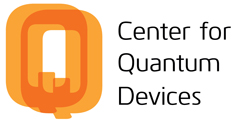Qdev seminar by Jaap Wesdorp, Delft University of Technology
Spectroscopy and manipulation of spinful Andreev states using superconducting circuits.
Abstract: Andreev bound states are fermionic states localized in weak links between superconductors which can be occupied with spinful quasiparticles. Hybrid circuits, where a superconducting resonator is coupled to a mesoscopic element has recently gained interest in the condensed matter community because it allows probing physical quantities with much higher energy and time resolution as compared to conventional transport studies. Additionally, coupling mesoscopic degrees of freedom to microwave photons facilitates their coherent manipulation and readout using conventional microwave techniques. We focus on proximitized semiconductor nanowire Josephson junctions as the mesoscopic element. After a general introduction, I will discuss two recent experiments where we embed a hybrid semiconducting InAs nanowire Josephson junction proximitized with an Al shell directly in a field compatible superconducting circuit to perform spectroscopy and manipulation of Andreev spins.
Part 1: We use a flux-tunable superconducting circuit in external magnetic fields to perform spectroscopy of spin-polarized Andreev states up to ~250 mT. We identify singlet and triplet states of two quasiparticles occupying different Andreev states through their dispersion in magnetic field. These states are split by exchange interaction and couple via spin-orbit coupling, analogously to two-electron states in quantum dots. We also show that the magnetic field allows to drive a direct spin-flip transition of a single quasiparticle trapped in the junction. Finally, we measure a gate- and field-dependent anomalous phase shift of the Andreev spectrum, of magnitude up to approximately 0.7π. Our observations demonstrate new ways to manipulate Andreev states in a magnetic field and reveal spin-polarized triplet states that carry supercurrent.
Part 2 : Andreev spin qubits have recently emerged as an alternative qubit platform with realizations in semiconductor-superconductor hybrid nanowire Josephson junctions. In these qubits, the spin degree of freedom is intrinsically coupled to the supercurrent across the junction via the spin-orbit interaction, which facilitates fast, high-fidelity spin readout using circuit quantum electrodynamics techniques. Moreover, the spin-supercurrent coupling has been predicted to facilitate inductive multi-qubit coupling. In this work, we show strong supercurrent-mediated coupling between two distant Andreev spin qubits. This qubit-qubit interaction is of the longitudinal type and we show that it is both gate- and flux-tunable up to a coupling strength of 179 MHz. Finally, we show that the coupling can be switched off in situ using a magnetic flux. Our results demonstrate that integrating microscopic spin states into a superconducting qubit architectures can combine the advantages of both semiconductors and superconducting circuits and pave the way to fast, high-fidelity two-qubit gates between remote spins.

